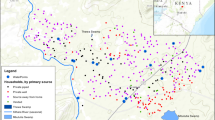Abstract
This paper analyzes the determinants of domestic water use in rural areas. The focus is on households without access to private improved water sources. These households use either only free sources, only purchased sources or a combination of free and purchased sources. We also analyze households’ water use behaviors as a function of water availability by explicitly estimating domestic water use for both rainy and dry seasons. Using a Seemingly Unrelated Tobit approach to simultaneously account for the censored nature of water demand and the correlation of error terms between free and purchased water use equations, we find that purchased water demand is perfectly price inelastic due to water scarcity. The important determinants of water use are household size and composition, access to water sources, wealth and time required for fetching water. Nevertheless, the effects of these determinants vary between household types and seasons, and the policy implications of the findings are discussed.
Similar content being viewed by others
References
Acharya G, Barbier E (2002) Using domestic water analysis to value groundwater recharge in the Hadejia-Jama’are floodplain, Northern Nigeria. Am J Agric Econ 84:415–426
Babel MS, Gupta AD, Pradhan P (2007) A multivariate econometric approach for domestic water demand modeling: an application to Kathmandu, Nepal. Water Resour Manag 21(3):573–589
Deaton A (1997) The analysis of household surveys: a microeconometric approach to development policy. The Johns Hopkins University Press, Baltimore
Engalenc M (1978) Les modalites de la recherche d’eau dans les roches cristallines fracturees de l’Afrique de l’Ouest. Bull CIEH 33–34:22–30
FAO (2003) Water availability per person per year. FOA AQUASTAT 2002. http://www.unesco.org/bpi/wwdr/WWDR_chart1_eng.pdf. Accessed Sept 2008
Froukh LM (2001) Decision-support system for domestic water demand forecasting and management. Water Resour Manag 15(6):363–382
Gazzinelli A, Souza MCC, Nascimento I et al (1998) Domestic water use in a rural village in Minas Gerais, Brazil, with an emphasis on spatial patterns, sharing of water, and factors in water use. Cad Sauda Publica 14:265–277
Gorter AC, Alberts JH, Gago JF, Sandiford P (1995) A randomized trial of the impact of rope-pumps on water quality. J Trop Med Hyg 98(4):247–255
Greene WH (1981) On the asymptotic bias of the ordinary least squares estimator of the Tobit model. Econometrica 49(2):505–513
Greene WH (2000) Econometric analysis, 4th edn. Prentice Hall, New Jersey
Hadjer K, Klein T, Schopp M (2005) Water consumption embedded in its social context, north-western Benin. Phys Chem Earth 30(6):357–364
HDR (Human Development Report) (2006) Beyond scarcity: power, poverty and the global water crisis. United Nations Development Programme, New York
Hinrichsen D, Robey B, Upadhyay UD (1997) Solutions for a water-short world. Population reports 14. Johns Hopkins School of Public Health, Population Information Program, Baltimore
Huang CJ, Sloan FA, Adamache KW (1987) Estimation of seemingly unrelated Tobit regressions via the EM algorithm. J Bus Econ Stat 5(3):425–430
Igue MA (2005) Soil Information System for the Oueme Basin. http://www.rivertwin.de/Publications&Reports.htm. Accessed May 2009
INSAE (Institut National de la Statistique et de l’Analyse Economique) (2003) Recensement General de la Population et de l’Habitation en 2002 (RGPH 3). INSAE, Cotonou, Benin
INSAE (Institut National de la Statistique et de l’Analyse Economique), ORC Macro (2002) Enquete Demographique et de Sante au Benin 2001. INSAE and Macro, Maryland
Keshavarzi AR, Sharifzadeh M, Haghighi AAK et al (2006) Rural domestic water consumption behavior: a case study in Ramjerd, Fars Province, I.R. Iran. Water Res 40(6):1173–1178
Madanat S, Humplick F (1993) A model of Household choice of water supply systems in developing countries. Water Resour Res 29(5):1353–1358
Nyong AO, Kanaroglou PS (1999) Domestic water use in rural semiarid Africa: a case study of Katarko village in the Northeastern Nigeria. Hum Ecol 27(4):537–555
Persson TH (2002) Household choice of drinking-water source in the Philippines. Asian Econ J 16(4):303–316
Sandiford P, Gorter AC, Orozco JG, Pauw JP (1990) Determinants of domestic water use in rural Nicaragua. J Trop Med Hyg 93(6):383–389
Sharma NP, Damhaug T, Gilgan-Hunt E et al (1996) African water resources: challenges and opportunity for sustainable development. World Bank Technical Paper 331. The World Bank, Washington
Silliman SE, Boukari M, Crane P et al (2007) Observations on elemental concentrations of the groundwater in central Benin. J Hydrol 335:374–388
Smale M, Meng E, Brennan JP, Hu R (2003) Determinants of spatial diversity in modern wheat: examples from Australia and China. Agric Econ 28:13–26
WHO (2005) Minimum water quantity needed for domestic uses. Technical note no 9
WHO, UNICEF (2006) Coverage estimates: improved drinking water, Benin. http://wssinfo.org/pdf/country/BEN_wat.pdf. Accessed Sept 2008
World Bank (2008) Benin at a glance. http://devdata.worldbank.org/AAG/ben_aag.pdf. Accessed May 2009
Yen ST, Lin BH (2002) Beverage consumption among US children and adolescents: full-information and quasi maximum-likelihood estimation of a censored system. Europ Rev Agric Econ 29(1):85–103
Zekri S, Dinar A (2003) Welfare consequences of water supply alternatives in rural Tunisia. Agric Econ 28:1–12
Zellner A (1962) An efficient method of estimating seemingly unrelated regression and tests of aggregation bias. J Am Stat Assoc 57:348–368
Author information
Authors and Affiliations
Corresponding author
Rights and permissions
About this article
Cite this article
Arouna, A., Dabbert, S. Determinants of Domestic Water Use by Rural Households Without Access to Private Improved Water Sources in Benin: A Seemingly Unrelated Tobit Approach. Water Resour Manage 24, 1381–1398 (2010). https://doi.org/10.1007/s11269-009-9504-4
Received:
Accepted:
Published:
Issue Date:
DOI: https://doi.org/10.1007/s11269-009-9504-4




